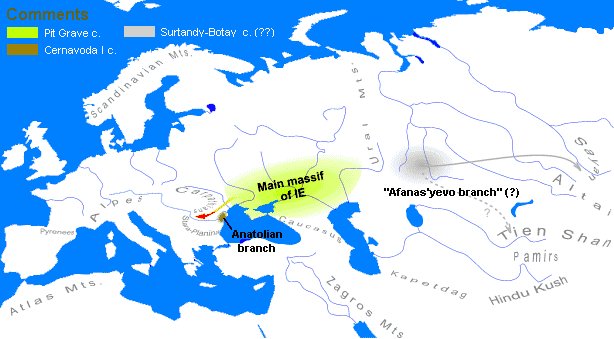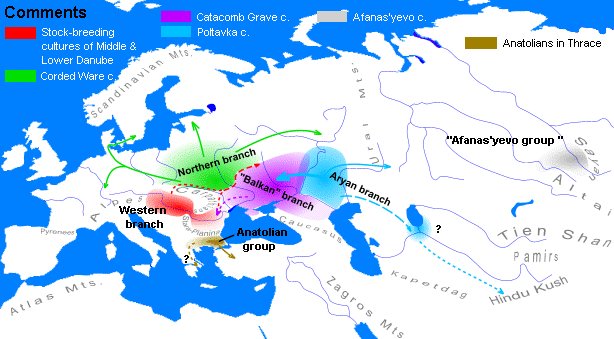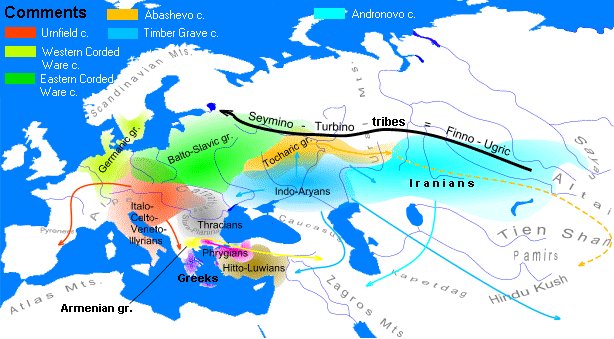INDO-EUROPEANS
The spreaders of Indo-European languages are traditionally considered to have been blond, blue-eyed Nordic types. However, scientists are not in agreement about the location of the Indo-Europeans' homeland, much less their original pigmentation, definitive records of which are lacking. One theory finds strong support in modern genetics, which shows today's Nordics to have comparatively little Indo-European ancestry. The other theory suggests that the Proto-Indo-Europeans may have been Mediterranean.
Anthropology"Two theories of the origins of the Indo-Europeans currently compete. M. Gimbutas believes that early Indo-Europeans entered southeastern Europe from the Pontic Steppes starting ca. 4500 B.C. and spread from there. C. Renfrew equates early Indo-Europeans with early farmers who entered southeastern Europe from Asia Minor ca. 7000 BC and spread through the continent."
* * *
The most widely accepted theory places the Indo-European homeland in the steppes north of the Black Sea, proposing the following routes for the spread of Indo-European languages and peoples:

4500-2500 B.C.

2500-1800 B.C.

1800-1200 B.C.
* * *
"The trajectory proposed here for migrations of the Indo-Europeans from a center in Southwest Asia to new territories in Eurasia, and for their contacts with speakers of other languages, correlates to some extent with the physical anthropological picture of migrations and racial blending in western Europe. There is an eastern Mediterranean, Balkan-Caucasian area of racial formation centered in Asia Minor (Alekseev 1974:224-25). In this area we can distinguish a Southwest Asian population group, widely attested in monuments in Southwest Asia (Luschan 1911, Bunak 1927, Field 1961). This physical type is characterized by marked brachycephaly, intensified development of facial and body hair, and a distinctive nose form (depicted, for example, in Hittite reliefs). It is typical of the tribes who were in contact with the ancient Near Eastern area, including the southern Caucasus, Asia Minor, and northern Iran, at a certain chronological level (Abduselisvili, 1966)...[and] is also represented in Europe, where it blends with the earlier types—northern, southern and central-eastern, the latter with Mongoloid admixture—which represent the original population (Alekseev 1974:225-41).
"The assumption that the Indo-Europeans were blue-eyed found some currency when northern Europe was regarded as the original Proto-Indo-European homeland, but placing the homeland in Southwest Asia changes the physical type that must be assumed. The migrations of the early Indo-European speakers and their interactions with local populations in their new territories would eventually have brought about fundamental changes in their physical type."
Genetics
"The distribution of HG 3 chromosomes is also strongly clinal, but with a very different axis and more on a regional scale.... It reaches its highest frequencies in central-eastern Europe, comprising approximately half of the chromosomes in the Russian, Polish, and Slovakian samples; frequencies in the southeast and southwest are low. This distribution resembles the third principal component of variation of classical gene frequencies, which has been interpreted by some geneticists (Cavalli-Sforza et al. 1994) as marking the movement, from north of the Caspian Sea, of the Kurgan people, dated to ~7,000 YBP."
HG3 Frequencies in European, Central Asian and Mediterranean groups:
| Poles...........54% Russians........47% Slovaks.........47% Belarusians.....39% Czechs..........38% Slovenians......37% Latvians........41% Lithuanians.....34% Norwegians......31% Ukrainians......30% Mari............29% Estonians.......27% Germans.........23% Hungarians......22% Lapps...........21% Icelanders......21% Romanians.......20% Swedes..........18% Chuvash.........18% Yugoslavs.......16% Dutchmen........13% |
Bulgarians......12% Finns...........10% East Anglians....9% Greeks...........8% Scots............7% Danes............7% Georgians........6% Armenians........6% Turks............5% Frenchmen........5% Belgians.........4% Ossetians........2% Cypriots.........2% Spaniards........2% Italians.........1% Portuguese.......1% Irishmen.........1% Cornish..........0% Basques..........0% Algerians........0% North Africans...0% |
Related Topics
European Genetic Variation: Indo-European ancestry comprises the 3rd component of variation.
The Indo-European Database: Large amount of information about Indo-European languages and peoples.
Indo-European Origins in SE Europe: Proposing a Balkan origin for Indo-European languages.
